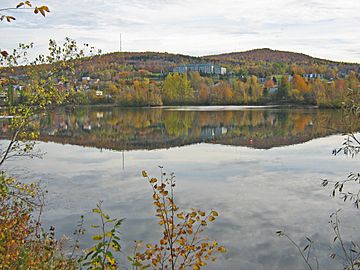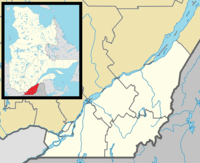Mont Bellevue facts for kids
Quick facts for kids Mont Bellevue |
|
|---|---|

View of Mounts Bellevue and John-S.-Bourque from across the Magog River
|
|
| Highest point | |
| Elevation | 333 m (1,093 ft) |
| Parent peak | John-S.-Bourque |
| Geography | |
| Parent range | Green Mountains |
| Topo map | NTS: 021E05 |
| Climbing | |
| Easiest route | hiking or cycling |
Mont Bellevue is a mountain in Sherbrooke, Quebec, Canada. It stands about 333 m (1,093 ft) tall. This mountain is part of a large public park in the Mont-Bellevue area.
The park also includes another mountain called Mont John-S.-Bourque, which is 365 m (1,198 ft) high. The park covers a huge area of 200 ha (490 acres) and has 30 km (19 mi) of trails. It is the biggest park in Sherbrooke, making up 20% of all park land in the city.
Contents
What Does "Bellevue" Mean?
The name Belle vue comes from French and means "beautiful view." The mountain, its park, and the part of the city where it is located are all named this way. This is because of the amazing views you can see from the top of the mountain.
History of Mont Bellevue Park
The land where Mont Bellevue Park is now was first used by the Université de Sherbrooke. This university was built in 1954. They used the area for sports, fun activities, learning, and research.
In 1959, the City of Sherbrooke built the first ski lift on the mountain. This was the start of making Mont Bellevue a place for everyone to enjoy. Between 1959 and 1975, the city set aside 45 hectares of land for skiing, tennis, archery, and different trails.
Since 1976, the City of Sherbrooke has been in charge of taking care of the park. They work with an organization called Regroupement du Mont Bellevue. Together, they keep making the park better while also protecting the environment.
In August 2013, Mont Bellevue was a special place for the 2013 Canada Summer Games. These are big sports events for young athletes. To get ready, the Club de vélo de montagne de Sherbrooke helped improve the park's mountain bike course.
Fun Activities at Mont Bellevue
Mont Bellevue has a small place for alpine skiing. It has six ski runs and a building where you can rent skis, snowboards, or snowshoes.
In winter, you can also enjoy cross-country skiing, winter walking, and snow tubing in the park.
When it's warmer, visitors can go hiking, mountain biking, cycling, archery, tennis, jogging, and geocaching.
Wildlife in the Park
Many different animals live in Mont Bellevue Park. You can often see deer, squirrels, and chipmunks. Sometimes, you might also spot porcupines, skunks, and raccoons.
Many kinds of birds live here too, like blue jays, cardinals, wood thrush, veery, and ruffed grouse. You might also find reptiles like brown snakes and garter snakes. Plus, there are many types of amphibians, snails, and insects.
Plants and Flowers
The mountain is home to a wide variety of plants. These include wildflowers, ferns, trees, plants you can eat, and different kinds of fungus.
Wildflowers
- Trout lilies
- Pink turtlehead
- Lily of the valley
- Foamflower
- Blue cohosh
- Pink streptope
- Solomon's seal
- Painted trillium
- Pink lady's slipper
- Jack-in-the-pulpit
- Common hemp-nettle
- Euphrasia
- Silvery cinquefoil
- Common mullein
- Indian pipe
- Pinesap
- Ground pine
Edible Fruits and Vegetables
Trees
Invasive Species
Some plants that are not native to the area have grown on the mountain. These are called invasive species. They can sometimes harm the local plants and animals. Examples include buckthorn, honeysuckle, and Japanese knotweed.
The Black Slug: An Invasive Animal
The black slug (called limace noire in French) is an invasive animal that came from Europe. It arrived in the area when the Université de Sherbrooke was being built in the 1950s. It is thought that slug eggs came in wooden crates from England. These crates were used to ship windows and were packed with straw.
The black slugs then moved into Mont Bellevue Park. The park's moist soil helps them move around easily. These slugs are very big and do not have a shell. This means they can easily take over food and space from native slug species. Also, not many animals in North America eat black slugs. This makes them a threat to the balance of nature on the mountain.
People are worried that these slugs might spread to other parts of the city. This could happen if they accidentally hitch a ride on cars parked near Mont Bellevue or the university.
Efforts to Control the Slugs
In 2008, people living near the park reported big problems with these slugs. The slugs were eating their gardens. City leaders then asked government officials for help.
In early 2009, the city made plans to try and get rid of the slugs. They hired a company to study how many slugs there were and where they were located. However, that summer, there were still a lot of slugs.
The study found that some slugs start having babies earlier than usual. This means they can have two groups of babies each year instead of just one. Warm autumns and winters, along with wet springs and summers, help the slug population grow even more.
After the study, the city started giving out information to homeowners. These brochures explain how people can get rid of the slugs on their own properties.
See also
 In Spanish: Monte Bellevue para niños
In Spanish: Monte Bellevue para niños


